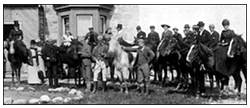|


 |
|
| Bill
Barry, Saskatchewan place name expert |
Back in my teaching days, Crossing the Bar by Alfred, Lord Tennyson,
was a compulsory part of the Grade XII English curriculum.
Sunset and evening star,
And one clear call for me!
And may there
be no moaning of the bar
When I put out to sea…
It is a moving metaphor for the poet's own death (which occurred
just two years after Crossing the Bar first appeared in 1890), and
I enjoyed teaching it. Maybe some of my students even remembered
it past recess!
By the time of his death, Tennyson was one of the best loved English
poets of all time. Today his verse is unmistakably Victorian, but
many of his poems have a timeless quality that ensures their survival.
Interestingly, Tennyson first came to fame with In Memoriam, over
a hundred lyrics dedicated to the memory of his close friend Arthur
Henry Hallam, who died unexpectedly in 1833 while still in his early
twenties. And thereby hangs the poet's first connection to Saskatchewan:
in 1908, CPR named the HALLAM siding between Macklin and Primate
to honour the bosom companion of Tennyson's youth. There was also
a TENNYSON School District No. 362 north of Flaxcombe, 1911-46.
 |
| Bertram Tennyson |
But there is an even more interesting connection. Bertram Tennyson
QC was the poet's favourite nephew, and he spent much of his short
life on the Canadian prairies. He homesteaded in 1881 beside William
Syme Redpath just north of where the village of Gerald is today.
REDPATH acquired a post office (1884-1909) which he named after
himself, and he carried the mail from Moosomin until he left to
manage the Anglican Church's St. Johns College Farm at Qu'Appelle
in 1889. Redpath later practised law at Regina, journalism at Winnipeg,
and farmed again at Mather, Manitoba.
Bertram Tennyson, in the meantime, proved unsuited to agricultural
pursuits and became a stage driver, operating a line from Moosomin
to Redpath and on to Sumner and Kinbrae, north of Esterhazy. He
also fought as part of Bolton's Scouts during the North West Rebellion.
But it was the law that was increasingly gaining his attention.
He studied under the tutelage of Edward L. Wetmore, then a judge
at Moosomin and later the first chief justice of the province of
Saskatchewan. Tennyson was evidently not without talent for he was
called to the bar in 1891.
 |
| The Moosomin-Cannington Combines, western rugby champions in 1891. |
That same year Tennyson became one of the better known residents
of the northwest as one of the stars of the Moosomin-Cannington
Combines. That team journeyed to Winnipeg where they defeated a
team of North West Mounted Policemen as well as two other teams
to become the western rugby champions - decades before the Roughriders
were even thought of!
The lure of the Klondyke was too strong, however, and Tennyson
left a blossoming legal career to travel to the Yukon in 1899. By
the time he arrived, the gold mines had all been staked and he decided
to go "home" to England. He had barely arrived when he caught a
fatal bout of influenza and died in 1900 in his early forties.
 |
| The Moosomin Hunt Club in 1893. Tennyson is in the centre of the photo, his hand on the white horse’s mane. |
So, was there anything of Alfred in young Bertram? I'll let you
judge for yourself. Bertram Tennyson published a short book of verse
in the mid-1890s which included a poem entitled The Long Dogs which
compares hunting coyotes on the prairies to the English fox hunt.
Here are the last two stanzas:
The dim grey shadow drifts ahead, our quarry never met,
For wind
and stoutness, speed and craft, his prairie equal yet;
But all
in vain the distant bush, in vain his prairie lore,
For those
are hard behind him now he never raced before.
Old Bran has got
him by the throat, and Mischief by the back;
He's down, and snapping
right and left amongst the tearing pack;
Light down, and break
the silence now with no uncertain sounds,
Who-whoop! Above the
dying brute and fling him to the hounds.
(Much of the foregoing is derived from a booklet entitled Tennyson
at Moosomin published by Gilbert McKay in 1975.)
Contact Us
| Contents |
Advertising
| Archives
| Maps
| Events | Search |
Prints 'n Posters | Lodging
Assistance | Golf |
Fishing |
Parks |
Privacy |
© Copyright (1997-2012) Virtual Saskatchewan
|

